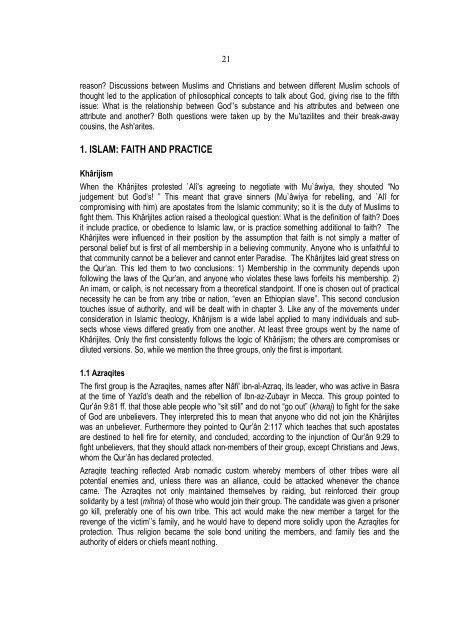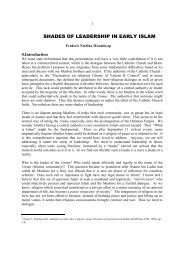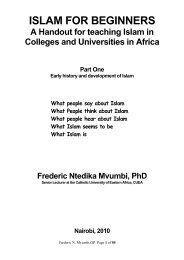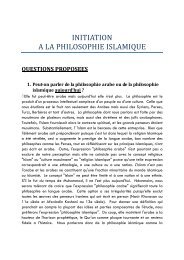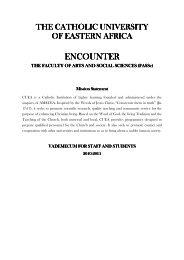INTRODUCTION TO ISLAMIC THEOLOGY.pdf - CUEA
INTRODUCTION TO ISLAMIC THEOLOGY.pdf - CUEA
INTRODUCTION TO ISLAMIC THEOLOGY.pdf - CUEA
Create successful ePaper yourself
Turn your PDF publications into a flip-book with our unique Google optimized e-Paper software.
21reason? Discussions between Muslims and Christians and between different Muslim schools ofthought led to the application of philosophical concepts to talk about God, giving rise to the fifthissue: What is the relationship between God’’s substance and his attributes and between oneattribute and another? Both questions were taken up by the Mu’tazilites and their break-awaycousins, the Ash’arites.1. ISLAM: FAITH AND PRACTICEKhârijismWhen the Khârijites protested `Alî’s agreeing to negotiate with Mu`âwiya, they shouted “Nojudgement but God’s! ” This meant that grave sinners (Mu`âwiya for rebelling, and `Alî forcompromising with him) are apostates from the Islamic community; so it is the duty of Muslims tofight them. This Khârijites action raised a theological question: What is the definition of faith? Doesit include practice, or obedience to Islamic law, or is practice something additional to faith? TheKhârijites were influenced in their position by the assumption that faith is not simply a matter ofpersonal belief but is first of all membership in a believing community. Anyone who is unfaithful tothat community cannot be a believer and cannot enter Paradise. The Khârijites laid great stress onthe Qur’an. This led them to two conclusions: 1) Membership in the community depends uponfollowing the laws of the Qur’an, and anyone who violates these laws forfeits his membership. 2)An imam, or caliph, is not necessary from a theoretical standpoint. If one is chosen out of practicalnecessity he can be from any tribe or nation, “even an Ethiopian slave”. This second conclusiontouches issue of authority, and will be dealt with in chapter 3. Like any of the movements underconsideration in Islamic theology, Khârijism is a wide label applied to many individuals and subsectswhose views differed greatly from one another. At least three groups went by the name ofKhârijites. Only the first consistently follows the logic of Khârijism; the others are compromises ordiluted versions. So, while we mention the three groups, only the first is important.1.1 AzraqitesThe first group is the Azraqites, names after Nâfi' ibn-al-Azraq, its leader, who was active in Basraat the time of Yazîd’s death and the rebellion of Ibn-az-Zubayr in Mecca. This group pointed toQur’ân 9:81 ff. that those able people who “sit still” and do not “go out” (kharaj) to fight for the sakeof God are unbelievers. They interpreted this to mean that anyone who did not join the Khârijiteswas an unbeliever. Furthermore they pointed to Qur’ân 2:117 which teaches that such apostatesare destined to hell fire for eternity, and concluded, according to the injunction of Qur’ân 9:29 tofight unbelievers, that they should attack non-members of their group, except Christians and Jews,whom the Qur’ân has declared protected.Azraqite teaching reflected Arab nomadic custom whereby members of other tribes were allpotential enemies and, unless there was an alliance, could be attacked whenever the chancecame. The Azraqites not only maintained themselves by raiding, but reinforced their groupsolidarity by a test (mihna) of those who would join their group. The candidate was given a prisonergo kill, preferably one of his own tribe. This act would make the new member a target for therevenge of the victim’’s family, and he would have to depend more solidly upon the Azraqites forprotection. Thus religion became the sole bond uniting the members, and family ties and theauthority of elders or chiefs meant nothing.


